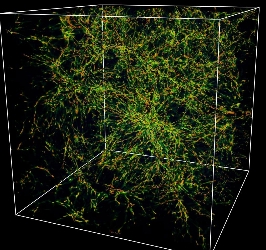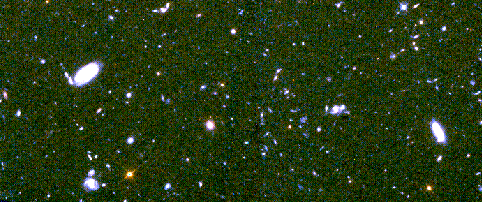Formation of Galaxies and Large-Scale Structure
A hot topic in astrophysics is the formation of galaxies and the
large-scale clustering and superclustering that they show. In brief, the
dark matter tells matter where to clump, but the gas has to cool by molecular
processes before it can form galaxy-sized (let alone star-sized)
lumps.
 Simulations and observations agree
that much of the material
formed a cosmic web of hot gas. The most promising sites for
collecting lage amounts are at the "nodes" of this web. It was
here that the first stars formed. This generation differed from the
sucessors we see by day and night in being purely of hydrogen and helium.
This made them more massive and hotter than any present-day stars.
They lived fast and died young. Much of their material was
fused to make heavier elements (such as carbon, nitrogen, oxygen...)
and splashed through the Universe when they exploded as supernovae.
Galaxy formation had to start all over again, but even the part in
a million of heavy elements ("metals") they left behind changed the
whole process.
Simulations and observations agree
that much of the material
formed a cosmic web of hot gas. The most promising sites for
collecting lage amounts are at the "nodes" of this web. It was
here that the first stars formed. This generation differed from the
sucessors we see by day and night in being purely of hydrogen and helium.
This made them more massive and hotter than any present-day stars.
They lived fast and died young. Much of their material was
fused to make heavier elements (such as carbon, nitrogen, oxygen...)
and splashed through the Universe when they exploded as supernovae.
Galaxy formation had to start all over again, but even the part in
a million of heavy elements ("metals") they left behind changed the
whole process.
Galaxies began to form as the newly enriched gas could cool
much more efficiently (for reasons having to do with the spectral lines
of heavier atoms). This process was well along at the earliest
times we can now see galaxies, about 0.8 billion years into cosmic history.
Stars formed as some of the gas collapsed far enough to ignite nuclear fusion,
and began the cycle of processing gas into heavier elements and ejecting them
into the interstellar medium to form further generations of stars. This
is intricate enough that it has fairly been termed
galactic ecology. We can see a relationship
between the ages of stars and the levels of heavy elements they
contain, as this process has played out over galactic history.
Much of this process can be observed directly by looking at galaxies
at great distances (10 billion light-years), since a telescope can't
help being a time machine. As examples, many of the galaxies in this
deep Hubble Space Telescope field have yet to acquire the symmetric
shapes of present-day spiral or elliptical galaxies.

As the internal evolution of galaxies proceeded, transforming their
diffuse gas into stars and triggering further chemical enrichment
and star formation, the clustering of galaxies likewise developed.
Many galaxies belong to rich clusters, and most belong at least to groups.
In addition to what we see, galaxies, groups, and clusters have their
dynamics dominated by the mysterious dark matter. We can also see that
the environment affectes galaxies; spiral galaxies are transformed into
gas-poor ellipticals in the busy regions of rich clusters. These clusters
also contain cast-off gas from exploding stars, heated to millions of degrees.
Galaxies aren't as isolated as they look.
More details:
Lecture notes on galaxy formation,
large-scale structure, and
intergalactic gas
keel@bildad.astr.ua.edu
Last changes: 8/2002
A hot topic in astrophysics is the formation of galaxies and the
large-scale clustering and superclustering that they show. In brief, the
dark matter tells matter where to clump, but the gas has to cool by molecular
processes before it can form galaxy-sized (let alone star-sized)
lumps.
 Simulations and observations agree
that much of the material
formed a cosmic web of hot gas. The most promising sites for
collecting lage amounts are at the "nodes" of this web. It was
here that the first stars formed. This generation differed from the
sucessors we see by day and night in being purely of hydrogen and helium.
This made them more massive and hotter than any present-day stars.
They lived fast and died young. Much of their material was
fused to make heavier elements (such as carbon, nitrogen, oxygen...)
and splashed through the Universe when they exploded as supernovae.
Galaxy formation had to start all over again, but even the part in
a million of heavy elements ("metals") they left behind changed the
whole process.
Simulations and observations agree
that much of the material
formed a cosmic web of hot gas. The most promising sites for
collecting lage amounts are at the "nodes" of this web. It was
here that the first stars formed. This generation differed from the
sucessors we see by day and night in being purely of hydrogen and helium.
This made them more massive and hotter than any present-day stars.
They lived fast and died young. Much of their material was
fused to make heavier elements (such as carbon, nitrogen, oxygen...)
and splashed through the Universe when they exploded as supernovae.
Galaxy formation had to start all over again, but even the part in
a million of heavy elements ("metals") they left behind changed the
whole process.
Galaxies began to form as the newly enriched gas could cool
much more efficiently (for reasons having to do with the spectral lines
of heavier atoms). This process was well along at the earliest
times we can now see galaxies, about 0.8 billion years into cosmic history.
Stars formed as some of the gas collapsed far enough to ignite nuclear fusion,
and began the cycle of processing gas into heavier elements and ejecting them
into the interstellar medium to form further generations of stars. This
is intricate enough that it has fairly been termed
galactic ecology. We can see a relationship
between the ages of stars and the levels of heavy elements they
contain, as this process has played out over galactic history.
Much of this process can be observed directly by looking at galaxies
at great distances (10 billion light-years), since a telescope can't
help being a time machine. As examples, many of the galaxies in this
deep Hubble Space Telescope field have yet to acquire the symmetric
shapes of present-day spiral or elliptical galaxies.

As the internal evolution of galaxies proceeded, transforming their
diffuse gas into stars and triggering further chemical enrichment
and star formation, the clustering of galaxies likewise developed.
Many galaxies belong to rich clusters, and most belong at least to groups.
In addition to what we see, galaxies, groups, and clusters have their
dynamics dominated by the mysterious dark matter. We can also see that
the environment affectes galaxies; spiral galaxies are transformed into
gas-poor ellipticals in the busy regions of rich clusters. These clusters
also contain cast-off gas from exploding stars, heated to millions of degrees.
Galaxies aren't as isolated as they look.
A hot topic in astrophysics is the formation of galaxies and the large-scale clustering and superclustering that they show. In brief, the dark matter tells matter where to clump, but the gas has to cool by molecular processes before it can form galaxy-sized (let alone star-sized) lumps.
 Simulations and observations agree
that much of the material
formed a cosmic web of hot gas. The most promising sites for
collecting lage amounts are at the "nodes" of this web. It was
here that the first stars formed. This generation differed from the
sucessors we see by day and night in being purely of hydrogen and helium.
This made them more massive and hotter than any present-day stars.
They lived fast and died young. Much of their material was
fused to make heavier elements (such as carbon, nitrogen, oxygen...)
and splashed through the Universe when they exploded as supernovae.
Galaxy formation had to start all over again, but even the part in
a million of heavy elements ("metals") they left behind changed the
whole process.
Simulations and observations agree
that much of the material
formed a cosmic web of hot gas. The most promising sites for
collecting lage amounts are at the "nodes" of this web. It was
here that the first stars formed. This generation differed from the
sucessors we see by day and night in being purely of hydrogen and helium.
This made them more massive and hotter than any present-day stars.
They lived fast and died young. Much of their material was
fused to make heavier elements (such as carbon, nitrogen, oxygen...)
and splashed through the Universe when they exploded as supernovae.
Galaxy formation had to start all over again, but even the part in
a million of heavy elements ("metals") they left behind changed the
whole process.
Galaxies began to form as the newly enriched gas could cool much more efficiently (for reasons having to do with the spectral lines of heavier atoms). This process was well along at the earliest times we can now see galaxies, about 0.8 billion years into cosmic history. Stars formed as some of the gas collapsed far enough to ignite nuclear fusion, and began the cycle of processing gas into heavier elements and ejecting them into the interstellar medium to form further generations of stars. This is intricate enough that it has fairly been termed galactic ecology. We can see a relationship between the ages of stars and the levels of heavy elements they contain, as this process has played out over galactic history. Much of this process can be observed directly by looking at galaxies at great distances (10 billion light-years), since a telescope can't help being a time machine. As examples, many of the galaxies in this deep Hubble Space Telescope field have yet to acquire the symmetric shapes of present-day spiral or elliptical galaxies.

As the internal evolution of galaxies proceeded, transforming their diffuse gas into stars and triggering further chemical enrichment and star formation, the clustering of galaxies likewise developed. Many galaxies belong to rich clusters, and most belong at least to groups. In addition to what we see, galaxies, groups, and clusters have their dynamics dominated by the mysterious dark matter. We can also see that the environment affectes galaxies; spiral galaxies are transformed into gas-poor ellipticals in the busy regions of rich clusters. These clusters also contain cast-off gas from exploding stars, heated to millions of degrees. Galaxies aren't as isolated as they look.
More details:
keel@bildad.astr.ua.edu
Last changes: 8/2002